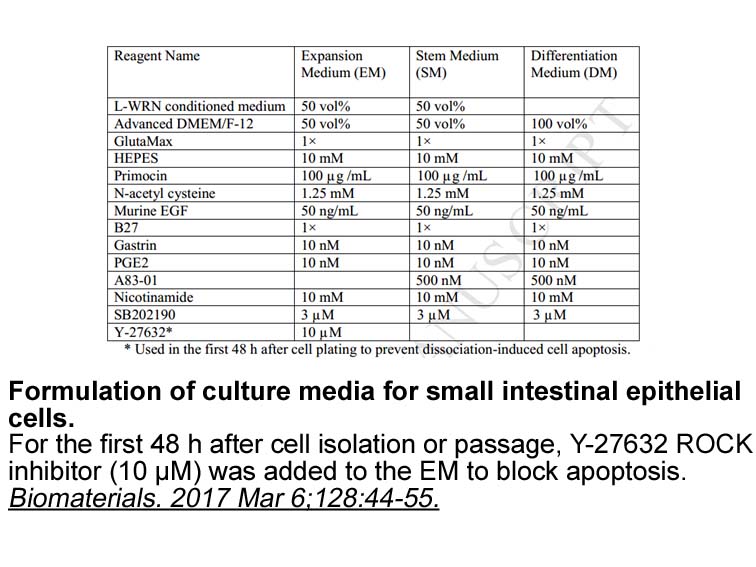Archives
Waldeck Weiermair et al demonstrated that in endothelial cel
Waldeck-Weiermair et al. (2008) demonstrated that in endothelial cells, the activation of GPR55 by application of 10µM anandamide resulted in a marked increase of ERK1/2 phosphorylation that was evident 2min following drug activation and was sustained for up to 3h. Another example comes from our unpublished observations in hGPR55E-U2OS cells where treatment with 10µM LPI resulted in a marked increase of ERK1/2 phosphorylation that was evident already 5min following drug treatment and was sustained for at least 2h. The outcome of this nature of ERK1/2 phosphorylation has to be further investigated since, as previously reported, it can be indicative of either a precursor of cell death or a survival signal, suppressing apoptosis (Correa et al., 2005, Galve-Roperh et al., 2008, He et al., 2004, Sarfaraz et al., 2006).
Several studies have reported morphological changes following activation of GPR55 (Kapur et al., 2009, Oka, Toshida, Maruyama, et al., 2009b). In cells co-transfected with hGPR55 and PKCβII-GFP within 60s of addition of agonists, membrane rearrangements began to occur followed by protrusions and blebbing (Kapur et al., 2009). Cytoskeletal changes were also observed in the β-arrestin trafficking assay upon addition of agonist (Kapur et al., 2009). Further, the necessity of an intact Indacaterol Maleate synthesis cytoskeleton was demonstrated to have a role in the release of calcium from intracellular stores following activation of the receptor, and was demonstrated to be induced by RhoA (Lauckner et al., 2008). In agreement with Lauckner et al (2008), Oka et al. (2009b) have recently reported that the morphological changes induced by 2-AG LPI can be abrogated by Y-27632, a specific inhibitor of ROCK, or C3 toxin, an inhibitor of RhoA. Thus activation of GPR55 links the Rho–ROCK pathway to the morphological changes, evident by the formation of actin stress fiber formation.
Potential mechanisms underlying the discrepant pharmacology of GPR55
Conclusions
The classification of GPR55 as a cannabinoid receptor at this time is problematic, due to the conflicting reports on the ligands with which it interacts. Until this controversy is resolved, GPR55 can be regarded as an “atypical” cannabinoid receptor. A consensus among the papers published on GPR55 is that LPI is an agonist for this receptor. In addition, several compounds that are regarded as cannabinoids are agonists, partial agonists and antagonists at GPR55. Another agreement among reports is that the aminoalkylindole, WIN55212-2, a potent CB1 and CB2 receptor agonist, does not activate GPR55. An anandamide- and WIN-sensitive GPCR present in CB1 knockout animals had previously been described (Breivogel et al., 2001, Di Marzo et al., 2000, Monory et al., 2002); clearly GPR55 is not this receptor. Therefore, additional cannabinoid receptors remain to be discovered.
GPR55 has been shown to utilize Gq and G12/13 for signal transduction; PLC and RhoA are activated (Henstridge, Arthur and Irving, 2009a, Kapur et al., 2009, Lauckner et al., 2008). This signaling mode is associated with temporal changes in cytoplasmic calcium, membrane-bound diacylglycerol, and plasma membrane topology. LPI, SR141716A and AM251 recruit PKCβII-GFP and cause widespread plasma membrane remodeling upon GPR55 activation (Kapur et al., 2009). Involvement of the actin cytoskeleton was also reported by Lauckner et al., 2008, Sugiura et al., 2009. A summary of the intracellular signaling pathways initiated by GPR55 is presented in Fig. 3. One should note that although several Gα subunits have been implicated in signal initiation, it appears that activation of GPR55 results in the ultimate generation of the same intracellular molecules, leading to the activation of the MAPK pathways and transcription factors. Future studies determining the outcome of the suggested downstream signaling pathways will be important to delineate the role of GPR55 in cell growth, differentiation and cell death.
the role of GPR55 in cell growth, differentiation and cell death.